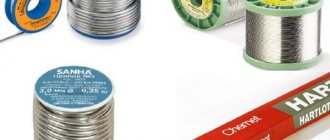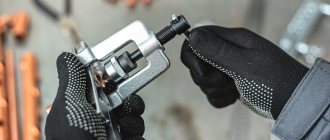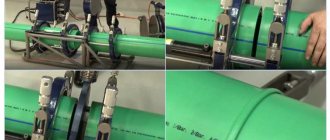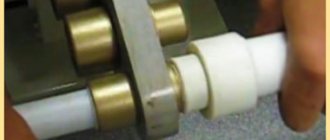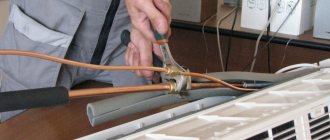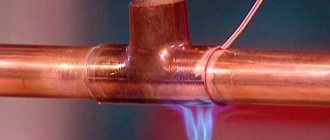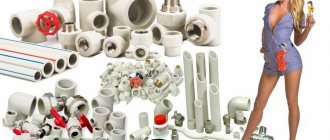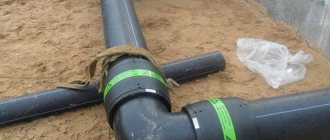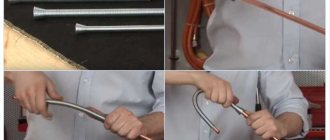Copper, brass and aluminum are the famous and most difficult trio for welding and any other metal work. The choice of method of connecting them is always not in favor of welding. The best solution is, of course, soldering. Its reliability and quality will depend on consumables, which must meet certain requirements.
In addition to this, let’s not forget that high-quality materials do not come cheap, so we will prepare for certain costs of both money and other resources in the form of effort, time and skill.
How is soldering of complex metals carried out?
It is not so different from the connection of other metals in its technology. For example, our process is copper and steel soldering. We will not escape from thoroughly cleaning the surface from the main enemy of good seams - oxide film. We will use a flux mixture to improve the soldering process.
Soldering flux table.
Between the workpieces, do not forget to leave a gap of adequate width - approximately 0.5 mm. Heating of metals must be carried out in the same way, without any new nuances. When the working temperature level is reached, we connect the solder to the parts.
Then leave the structure to cool as naturally as possible. Voila, no news or secrets from the mistress of the copper mountain. Where are the technological nuances, and what is the article about?
Of course, there is a nuance. Its name is copper solder. It's all about its quality and nature. It is excellent for working with both copper blanks and parts made from a wide variety of alloys, in which iron, nickel, phosphorus, tin, manganese and others are partners.
All the numerous options for alloys and their applications are set out in GOST 52955 - 2008. If oxides occur in such alloys, they can be removed without problems - in this case there are practically no problems when soldering with copper solder.
If “partner” metals have the ability to form oxides, which fluxes for soldering copper can handle with difficulty or cannot cope with at all, then problems may arise.
If we talk about the type of connections, then in soldering copper pipes an overlap type of seam with an overlap width of at least 5 mm is most often used. This is not the most aesthetic option for metal connections, but it is the most durable and durable.
Fortunately, in soldering you can form seams of any thickness without quality requirements, which cannot be achieved when welding with an electrode. The copper-phosphorus solder is perfectly drawn into the gap between the workpieces to fill all possible niches and gaps with the formation of excellent tightness of the connection.
Technological features of soldering copper tubes
Products of this type lend themselves well to processing. Phosphorus-copper and silver types are recommended for solder. The units themselves are distinguished by their significant tensile strength and demonstrate anti-vibration properties.
The mechanism for implementing the procedure has the following sequence:
- First, you need to get rid of the oxide film located in areas subject to soldering: for this purpose, it is common to use sandpaper. Dust generated during processing must also be removed.
- Next, the flux mixture is applied to the area prepared during cleaning. This solution is a compound of hydrazine, as well as various wood resins and rosin alcohol.
- The fitting is connected to the pipe. The gap must be less than half a millimeter.
- The connection point must be heated. The temperature for this should be about three hundred degrees. To solder copper tubes for air conditioners, you will need a special lamp, or, alternatively, a gas burner. Heating should be carried out as evenly as possible; for this, the flame should be regularly smoothly moved along the structure. There is no need to allow any specific area to overheat.
- Be sure to flush the system after completing the event, since residual flux contamination can potentially provoke metal corrosion, which, in turn, will lead to breakdown of the air conditioner.
Technological tips and notes
They concern the soldering of copper with steel and other additional metals:
- A mandatory requirement for copper solder is its well-molten state. This is necessary to fully fill the space between the connected surfaces.
- The mixture should spread over absolutely the entire surface, monitor this strictly.
- Flux is used to remove oxide film and any other types of dirt.
- The cost of these mixtures is in a very wide range, this is explained by the different compositions and technical characteristics of their alloys.
Advantages of soldering
Soldering copper.
Joining metals by soldering is a very popular technology.
There are serious reasons for this:
- Soldering does not deform the parts during the process; their shape remains original.
- There is no need to deal with the phenomena of warping and any internal stress.
- Strength and tightness of the formed seam.
- The independence of this technology and the quality of seams from various temperature conditions, including significant heating.
- Possibility of joining metal with non-metallic materials.
- Easy seam release.
Solder classification
Solders are divided into exactly two categories according to the following parameters:
- according to the chemical composition of the alloy, for example, phosphorus solder;
- by the height of the melting temperature;
It would be logical to consider the types of solders from the point of view of the physical properties of the resulting solder composition. The main factor is the characteristics of the metal and the companion alloy.
According to this criterion, the types differ as follows:
Low temperature or soft type of solder
Only 450°C is the maximum permissible level for the melting point in this form. This feature affects the strength of the joint, but not in the most critical way: it is slightly lower than that of hard solders.
However, the properties of the materials being joined do not change during the process, so the resulting strength is quite acceptable.
Within this species there are also subspecies based on the chemical composition:
- lead and lead-free;
- lead-tin alloys;
- special purpose and easy melting.
Solder for soldering copper.
Tin-copper solders consist of 97% tin and only 3% copper. This is a very popular mixture, and it is very inexpensive.
Tin-silver solders are stronger in properties than the previous ones; these are the most popular mixtures for soldering heating systems. Their fractional composition is almost the same: 95% is tin and 5% is silver.
The marking of soldering compounds is simple and clear. Let's take, for example, brands POS-18, POS-30 and so on. The numbers indicate the percentage of tin in the mixture. The POS-61 mixture is the most suitable option for working with copper and brass, while POS-30 is more versatile: in addition to copper and brass, it is suitable for soldering steel alloys and iron.
High temperature or hard type solder
It is clear that here the melting temperature level is much higher, sometimes reaching 800°C. This gives more strength to the seams; it is higher than when using “soft” solders.
Based on their chemical composition, hard alloys are divided into:
- copper-zinc;
- copper-phosphorus solders;
- pure copper, without impurities.
One of the main rules for the effective use of copper solder is its maximum compliance with the metal with which it will be connected during the soldering process. In this case, one more requirement must be met: the melting temperature of the alloy is lower than that of the base metal.
This is necessary due to the risk of damaging the structure of the part due to the base metal in copper, for example, thin-walled tubes.
Hard grades are used where stronger connections are needed. They contain hard solder alloys of the brands BCuP, Bag, etc. The quality and reliability of the connection depends on the fractional composition of different elements.
Hard solders are divided into:
- refractory
- fusible
Copper-zinc alloys are quite rare; they can be easily replaced with other mixtures containing bronze, brass or zinc.
Types of copper fittings.
Copper-phosphorus solder has the same properties and functions as the expensive version of the pure silver mixture for soldering workpieces made of bronze, brass, etc.
The markings here are slightly different: PMC-36, where the letter “P” stands for “solder”, “MC” stands for the words “copper-zinc”, and the number 36 stands for the percentage of copper in this composition.
According to the criteria of versatility and economic accessibility, copper-phosphorus solders are, of course, in first place. They are used in a wide variety of types of work, although they have a certain disadvantage. This is insufficient connection strength at low temperatures.
The strongest and most durable connections are obtained by using special multi-component mixtures. Copper-zinc solders also provide the same strength. The most common composition is: 92% copper, 2% silver, 6% phosphorus.
When working with hard grades, it is necessary to use flux mixtures. The type of flux and its volume must be selected correctly, based on the technical characteristics.
It should be noted that even small deviations from technology standards can lead to serious situations, including accidents.
Basic mistakes
Soldering defects include: the presence of flux inclusions, cracks, unaesthetic appearance of the connected area, cracking and tearing of the edge, as well as an unsoldered joint.
Basically, the success of an operation depends not so much on the quality of the starting materials used, but on the manufacturability and skill of its implementation.
Let us highlight the rules that must be followed when carrying out work:
- First you need to prepare the parts that will be connected
- We need a capillary that will create the necessary conditions for the solder to penetrate even the most difficult to reach areas
- There should be no oxide film on the treated surface of the air conditioner tube
- Application of paste-like flux
Note that soldering will not be of high quality if the parts that are subject to it do not heat up equally. The degree of uniformity of heat treatment of the air conditioner tube is determined by many factors: the weight and nature of the source materials, temperature, type of solder. In order to carry out the heating process, the installer can use the following methods: using an open flame, electrical resistance, and also use a metal soldering iron.
The last two types of conditioning procedures are used for its soft form at low temperatures. These methods are quite simple to implement and require simple and easily transportable equipment. They are not difficult to implement.
It is more difficult to work with an open flame; it is possible to use different types of solder; in such a situation, it is extremely important to take into account the temperature to which the connecting parts heat up. It is necessary to separate two systems: oxygen and gas, as well as gas and air.
To solder a copper air conditioner tube, you must burn either acetylene or propane. It is contained in heavy cylinders, which are quite difficult to transport.
The choice of solder depends on several factors. Often the most applicable are those containing silver particles, or even copper-phosphorus ones, which have a very wide range of uses.
The choice of the type of connecting mixture is determined by temperature indicators, as well as a set of tools that will be used to carry out the soldering itself.
A few words about fluxes
The most commonly used flux compositions are:
- A special flux for working with aluminum, in which the main element is tin with the addition of zinc, cadmium and borax. The zinc and cadmium in this mixture have a special function: they increase the force of diffusion.
- The so-called paste is a flux for soldering copper products. This is the same flux mixture, only its consistency is thicker than regular fluxes. The peculiarities of paste fluxes are their ability to enhance the adhesion of the compound and minimize the formation of air bubbles.
Aluminum is often used both in industry and at home. Solder for soldering aluminum must contain silicon, zinc, copper and silver. Alloys must be high temperature.
Pricing policy or how much you can buy a new copper pipe for a split system
The cost of the product is 42 rubles per linear meter. They go on sale in bays consisting of either fifteen or forty meters.
Pricing is influenced by the following factors:
- technologies used to produce the air conditioner tube;
- characteristics of the original metal itself;
- manufacturer's brand.
As an option, if there is a need to replace or solder the conductive device. You can contact a company that is engaged in both the supply of the products themselves and their installation.
How to choose solder for copper?
One of the most important criteria is the level of melting temperature. The higher this level, the higher the risk of damage to the base metal part. Much will depend on the wall thickness of the copper pipe.
If this wall is thick, it is difficult to burn through it and, therefore, the risk of damage is lower. In this case, it is quite acceptable to use the solid type for copper, which has a fairly high melting point level.
If you are working with thin-walled pipes, and high joint strength is not critical for them, choose a soft type of copper-phosphorus solder with a low melting point.
For soldering food-grade copper, there are special alloys that do not contain any toxic substances or poisonous elements.
Pros and cons of different types of solders
An important advantage that hard solders have is directly related to the strength of the resulting seams and their resistance to high temperatures. Using high-temperature soldering, copper pipes with a diameter of 6 to 159 millimeters are joined. When laying water supply lines, the cross-section of pipe products connected by this type of soldering cannot be less than 28 millimeters.
As practice shows, among the soft solders for joining copper pipes, the most popular is tin-copper, and among hard solders, copper-phosphorus ones are often used. Different companies have different manufacturing technology and percentage composition of components.
Before you start creating a copper pipeline, you should make sure that there are no defects on the surface, which can often be found when cutting pipes. The reliability of seams largely depends on the cleanliness of the products used in the work process. For products with a diameter of 6-108 millimeters, the width of the joint can be 7-50 millimeters.
Read also: An example of an interval scale is
The use of copper pipes allows you to create an efficient and durable heating or water supply system. The simplest and most common way to connect such products is soldering technology. It involves the presence of solder - a thermoplastic substance that seals the joint by melting and flowing under the influence of high temperature. After cooling, it hardens and fixes the connection.
Soldering of copper pipes is carried out with different types of solder

